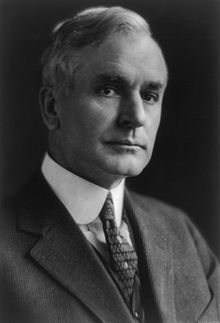Hull note
The Hull Note was a diplomatic note to the United States to Japan . It was presented on November 26, 1941 and was the de facto final point of negotiations between the two countries. The government of Japan took this note as an ultimatum and decided to enter the Second World War .
background
Since 1937, Japan waged the Second Sino-Japanese War in China . The United States was initially neutral, but its attitude changed in the years that followed due to the Panay incident and increased reports of Japanese atrocities such as B. the Nanking massacre in favor of China. The USA supported China to an increasing extent with material deliveries and a (formally non-US American) fighter squadron of volunteers . In addition, in early 1940 the USA warned Japan not to invade French Indochina and demonstratively moved its Pacific fleet from its home base in San Diego ( California ) to Pearl Harbor on Hawaii .
When Japan stationed troops in Indochina in July 1940, despite an American warning , the US government under President Franklin D. Roosevelt restricted US exports of oil and steel to Japan in September 1940 (at that time Japan obtained 80% of its oil the USA). When this did not have the desired effect and Japan stationed more troops in Indochina in July 1941, the USA imposed a complete oil embargo on Japan on July 25, 1941 and froze all Japanese assets. As the UK and the Dutch East Indies followed suit, Japan lost 75% of its foreign trade and 90% of its oil imports.
Japan's oil reserves for industry and the military only lasted for a few months without imports, so the Japanese leadership under Prime Minister Tōjō Hideki had to restore the oil supply within this time if they wanted to prevent the collapse of the empire. She saw only two options for doing this: Either the embargo could be lifted through negotiations with Washington in return for Japanese concessions, or Japan stopped supplying oil and other scarce resources by taking possession of the resource-rich Southeast Asian colonies of Great Britain, France and the Netherlands forcibly safe.
Japan started negotiations, but at the same time mobilized its military for war if the negotiations did not achieve the desired success.
The negotiations
The Japanese ambassador to Washington, Nomura Kichisaburō , as the Japanese negotiator, submitted proposal A to the US Secretary of State Cordell Hull on November 6, 1941 : cessation of hostilities in China, end of the war and partial withdrawal of Japanese troops from the occupied Chinese territories Lifting of economic sanctions.
However, the US intelligence service had cracked the diplomatic codes of the Japanese State Department , in particular the key machine Purple . Therefore, the US side knew that a proposal B existed, which Nomura should present in the event of rejection. They therefore rejected proposal A after a brief period of reflection on November 14th .
On November 20, Nomura tabled Proposal B : Suspension of Japanese military action against the United States supplying one million gallons (3800 m³) of aviation fuel. In response to this proposal, the US developed a counter offer based on the monthly supply of oil for civilian purposes. In the meantime, however, the US government learned of the Japanese preparations for war in Southeast Asia through its own and allied intelligence services . President Roosevelt then came to believe that the Japanese were only negotiating pretend and instructed Secretary of State Hull to drop the counter-proposal.
The grade
Instead of the counterproposal presented Secretary of State Hull Ambassador Nomura on November 26, a note entitled draft proposal for the basics of an agreement between the United States and Japan ( Outline of proposed Basis for Agreement Between The United States and Japan ). This document, now known as the Hull Note , called for the complete withdrawal of Japan from China and French Indochina , among other things . This was unacceptable to Japan. Prime Minister Tōjō Hideki described the note in front of the Japanese cabinet as an ultimatum . Japan then finally decided to go to war against the USA. The Japanese attack unit set out to attack Pearl Harbor on the same day . Negotiations were officially continued in Washington, but this only served as camouflage, although it would have been possible to call back the Japanese units if an agreement had been reached.
